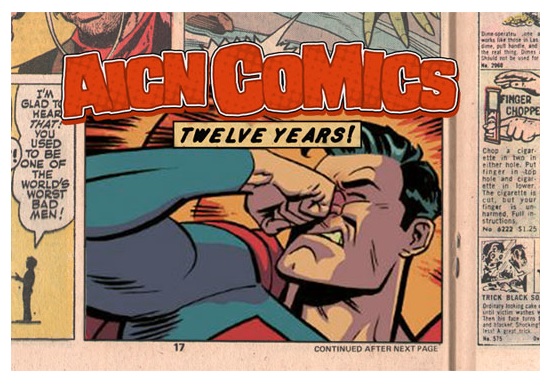
(Click title to go directly to the review)
ETERNAL WARRIOR #1
Advance Review: APHRODITE IX #5
X-MEN #5
DETECTIVE COMICS: HARLEY QUINN #23.2
Advance Review: THE OTHER DEAD #1
EARTH 2: SOLOMON GRUNDY #23.2
DEADPOOL #16
BATMAN: RIDDLER #23.2
Indie Jones: PARIAH, MISSOURI OGN
AQUAMAN: BLACK MANTA #23.1
INFINITY: THE HUNT #1
Indie Jones: TALL TALES FROM THE BADLANDS #3
Advance Review: UNWRITTEN: TOMMY TAYLOR AND THE SHIP THAT SANK TWICE OGN
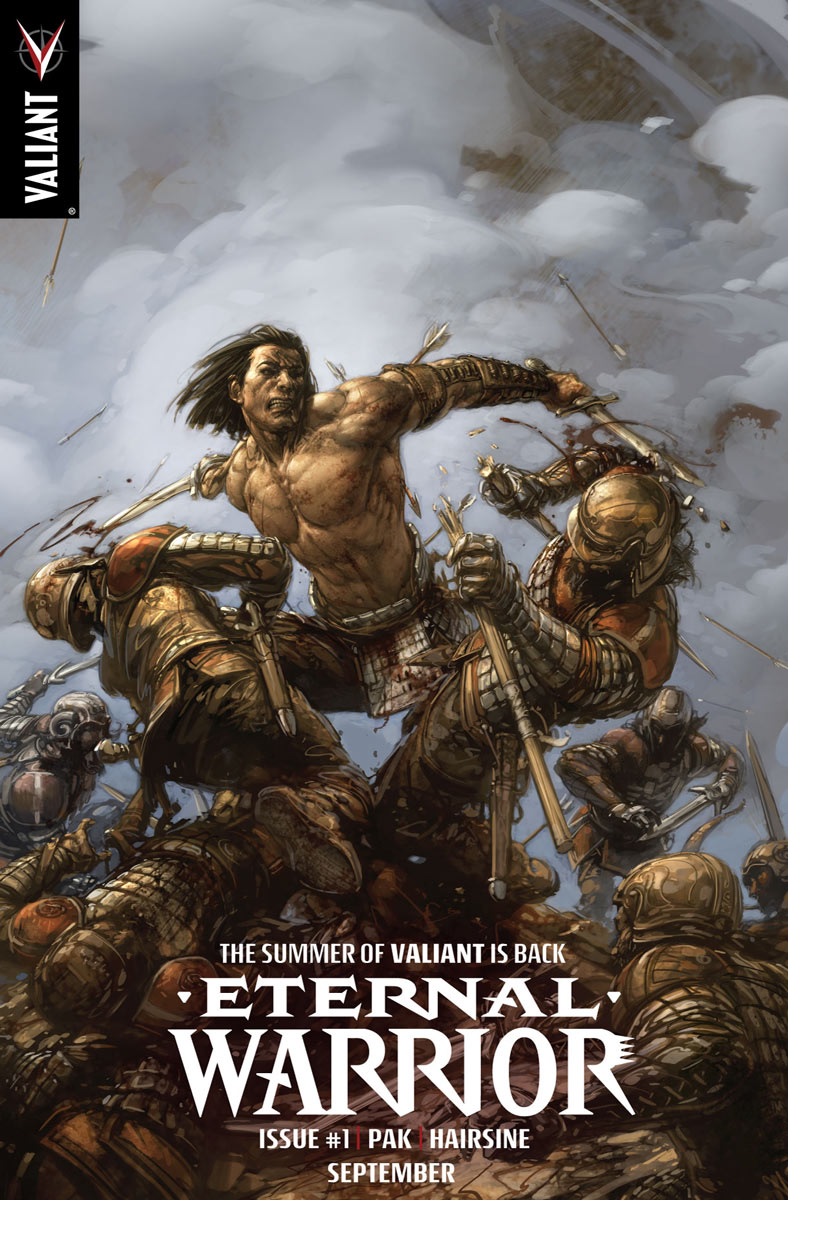
ETERNAL WARRIOR #1
Writer: Greg PakArtist: Trevor Hairsine
Publisher: Valiant Entertainment
Reviewer: Corey Michael Dalton
The new(ish) Valiant is a publishing company that's sorely needed in the comic book industry: a publisher that puts top-notch writers and artists on comics from a variety of genres (not just superheroes) and then lets those creators go wild. Even though Valiant's comics all take place in the same universe—and can, therefore, cross over with each other—each series has a distinct personality. X-O MANOWAR is sci fi CONAN, for example, while QUANTUM AND WOODY is a spoof of superheroes and ARCHER & ARMSTRONG is a conspiracy theory-tinged buddy comedy. Valiant doesn't go the easy route and create eight indistinguishable AVENGERS or BATMAN titles to sell to completists. Instead, they seem genuinely interested in putting out compelling stories for people who wouldn't know a Nightwing from a Nighthawk. Overall, I've been impressed by the quality of Valiant's comics over the past couple of years, and the company's latest title, ETERNAL WARRIOR, is no exception.
Issue 1 opens roughly 6000 years ago in Mesopotamia, where a robed wizard is consecrating the warriors of the Earth so they can battle the destructive hoards of the Death Cult of Nergal. The most badass of these warriors is Gilad, a.k.a. the Eternal Warrior. His title is no empty boast; much like the sword-wielders in HIGHLANDER, Gilad is immortal (but not invulnerable). Exactly why he's immortal is never really made clear in this issue, but it seems to have something to do with him being the chosen champion of Mother Earth. Ol’ Gilad has two kids: his son Mitu and his daughter Xaran, who both plan to fight alongside daddy dear on the front lines. But Gilad sends Xaran away to lead the evacuation instead—not because she's a girl, but because she takes a bit too much after her pa and has an intense bloodlust. Of course, the battle goes poorly for the warriors of Earth, but the tide is turned when Xaran shows up (in a perfect use of a full-page panel), disobeying her father's orders and riding an oliphaunt! Much as Gilad predicted, however, she goes a little crazy and she ends up butchering not just the women and children of the Cult of Nergal but her own brother as well. Oops. Cut to the present, where Gilad has retreated from society to live alone (well, with a dog) in a peaceful, remote cabin in Africa. Of course, Gilad can never really attain peace or there would be no story. Cue the arrival of an unexpected visitor—Xaran! It appears that Gilad's prodigal daughter is (surprise!) also an immortal warrior who now needs her father's help.
Greg Pak is a writer with whom I'm not terribly familiar. I remember enjoying his dialogue and sense of humor in Marvel's INCREDIBLE HERCULES, but I also remember not being enthralled by the story he was telling. Because this is a first issue and needs to set up the series as a whole, the story in this issue was much more to my liking: straightforward and plot-driven. Although the tragic events didn't allow for much humor, Pak did squeeze in a couple of funny lines such as Gilad's "Follow the crazy girl on the elephant!" One element of the writing that I could have done without was the first-person narration from Xaran throughout the battle at the beginning. It seemed like a cheap way to get inside her head and explain her actions while also tipping Pak's hand that Xaran was still alive, spoiling her return at the end of the issue. Plotwise, there are enough hooks to make me want to come back for issue 2. I want to know more about the trouble Xaran has gotten herself into, for example, and I'm also curious to know if there is an "Earth wizard" to guide Xaran and Gilad in the present. I remember that Valiant's comics from the '90s featured magical characters called Geomancers, so I'm assuming we'll be meeting one of those soon.
Artwise, this is some of the best work I've ever seen from Trevor Hairsine. His work here is dynamic and stylish, especially during the opening battle. At times, I get a bit of a Jim Cheung vibe from the art, which is definitely a good thing. The page depicting Xaran's timely arrival on the back of a giant war elephant, for example, is simply magnificent. Some of the credit must go to Brian Reber's coloring, too, of course. From bloody fields of battle to African sunsets, the colors were, by and large, spot on. The one place I had an issue with the coloring was in the final scene in Gilad's shack; things just became too dark and monochromatic.
In some ways, the set-up for this book is similar to the concept for Valiant's flagship title, X-O MANOWAR. Both titles feature ferocious, ancient warriors now transplanted to the present day to continue fighting their wars. The concepts have one big difference, however, which should establish Gilad as the flip side of Aric: Gilad lived through the intervening 6000 years and adapted (somewhat) with the changing world, but Aric slept through those years, which makes him basically the same barbarian today that he was thousands of years ago. That difference should make for an interesting clash of philosophies when the two characters inevitably meet. Gilad also reminds me of the best parts of Wolverine: an immortal warrior with a berserker rage who is perfectly suited to killing, but longs for peace and quiet. Let's just hope Gilad doesn't start showing up in every other Valiant comic…
Corey Michael Dalton has written and/or edited trade books, magazine articles, short stories, novels, comics, plays, review, websites, blogs, and more. You name it, he's probably written it. Except religious scriptures. He hasn't gotten around to those just yet.
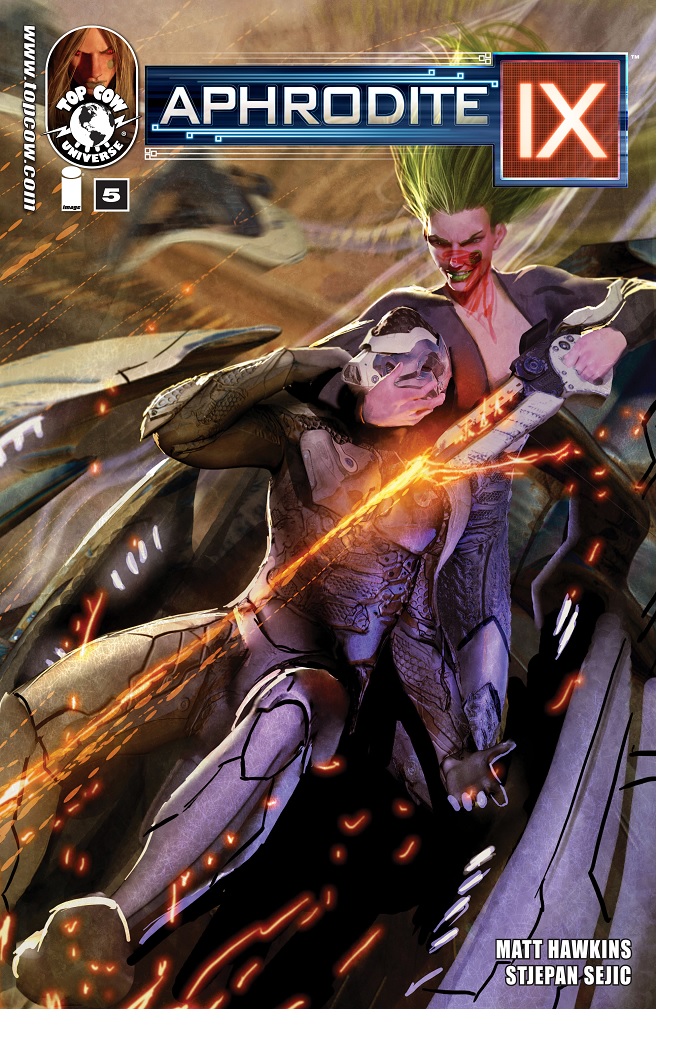 Advance review: In stores today!
Advance review: In stores today!APHRODITE IX #5
Writer: Matt HawkinsArtist: Stjepan Sejic
Publisher: Top Cow
Reviewer: Matt Adler
Aphrodite IX is Top Cow's resident femme fatale android killing machine, and although she was created back in 2000 by David Finch and David Wohl, this new incarnation is in the hands of writer Matt Hawkins and artist Stjepan Sejic, who have created a brand new world for her to operate in.
Set against the backdrop of a war between a genetically-enhanced religious faction from the city of Genesis on the one hand, and a cybernetically-enhanced militaristic faction from the city of Speros on the other, there are no real good guys or bad guys in Aphrodite's world, as she herself notes; the choice is ultimately between zealotry and totalitarianism. However, her personal relationship with Marcus, leader of the Genesis faction leads her to ultimately side with them against her creators in Speros, which provides an internal conflict in addition to the external one, as she struggles against the programming directives her creators continue to try to enforce.
The art by Stjepan Sejic, is as usual for him, gorgeous. Anyone who has followed his work on WITCHBLADE and other Top Cow series knows that Sejic goes far beyond typical "bad girl" fare, and renders worlds and characters in astonishing detail that leaves the reader lingering over each panel. The battle scenes, which in many comics might be paged through quickly, are filled to the brim with innovative and impressive designs. It's no slight to any of the other fine creators at Top Cow to say that he is, in my estimation, the publisher's greatest asset.
Sejic is paired with Matt Hawkins on this series, who is establishing a reputation for telling compelling, thought-provoking stories particularly with his creator-owned series, THINK TANK. This series is naturally a bit more removed from reality than that one, but Hawkins adjusts to the demands and creates a story that feels epic in scope, both in terms of establishing the cultures of the respective factions, and by populating the tale with plenty of high action and drama. The quieter moments succeed here too, and Hawkins ably portrays Aphrodite's inner conflict, as well as the sinister nature of those who are manipulating her for their own ends. I particularly appreciate that Hawkins manages to walk the line here, and avoid making this a struggle of good vs. evil; in the end, it's a struggle for a survival, and there is a definite sense that it may not even be a successful one at that.
This issue ends with Aphrodite on her own once more, which seems right for a being who really can't fit into either society, and must make her own way in order to remain free. I look forward to seeing what Hawkins and Sejic have next in store for this outsider whose primary mission seems to be to find her place in this strange world.
Matt Adler is a writer/journalist, currently writing for AICN among other outlets. He’s been reading comics for 20 years, writing about them for 7, and spends way, way, too much time thinking about them, which means he really has no choice but to figure out how to make a living out of them. He welcomes all feedback.

X-MEN #5
Writer: Brian WoodArtist: David Lopez
Publisher: Marvel Comics
Reviewer: Masked Man
BATTLE OF THE ATOM rages on! I'm one of those people who enjoys the X-Men as an adventure story, and not much more than that. I watched all the movies and liked them (even the third one--I think people who dump on the film forget about movies like “The Fantastic Four” and “Catwoman”). I watch all the cartoons, but I never really read the comics much. On some level I'm just not down with the 'my life sucks because I can fly and control fire' attitude the X-Men universe always seems to have. How people know to hate Cyclops and Quicksilver and embrace Daredevil and Spider-Man is always a mystery to me. That said, Bendis' Battle of the Atom was brought to my attention (I guess Bendis was feeling left out of the INFINITY crossover), and I thought I'd take a look.
Now, this is a ten part story, and we are only on chapter three, but wow, what a dull plot: whiny teenagers from the past don't want to go home, so they get chased by dull-witted adults from the present and the future (why are people from the future in every frick'n X-MEN comic I read???). This really doesn't seem like a big event crossover plot that needs ten issues. I also just read AGE OF ULTRON, which makes me a little nervous about another big Bendis crossover, but there is a ray of hope here.
Now, as much as the plot (so far) makes me go “that's it?!”, it has been fairly entertaining--enough so that I am willing to ride it out. I'm not sure how much credit to give to Bendis this issue, so I'm just going to give all the credit to Wood for the sake of concise writing. So what's the skinny? Well, 1960's Marvel Girl and Cyclops (don't ask) are on the run from the current X-Men and the X-Men from the future, because they don't want to return to the 1960's (there's no Facebook--let's be real). Mindblowing stuff, right? Well, it is handled really well with some good character moments, my favorite being Wolverine saying “Me what --?” And though this is a comic book, Wood tries his best to avoid turning this into a giant fight. The present and future X-Men are at least attempting to be adults about this. The curveball for future goodness in the issue is the last page, which I won't give away directly, but I will say it seems like some open sores from AVSX are about to be addressed, and as a non-mutant zombie, I look forward to that. While hoping it will be handled better than AVSX itself, mind you.
David Lopez (inked by Cam Smith) did a fine job with the artwork. His style reminds me of the great Carlos Pacheco: very clean and appealing to look at, though he's not quite as elegant as Pacheco yet. From the Art Adams' cover to the last surprise page, this is a very good-looking book.
X-Men fans are probably already eating this up with a spoon, but the soup is pretty tasty for the rest of us as well. And if the plot can get more interesting, matching up better with the fine execution, Marvel might actually pull off two good crossovers at the same time! That would be something to see.
Learn more about the Masked Man and feel free check out his comic book GOLD STAR, CINDY LI: THREE OF A KIND and CAPAIN ROCKET at www.Toonocity.com
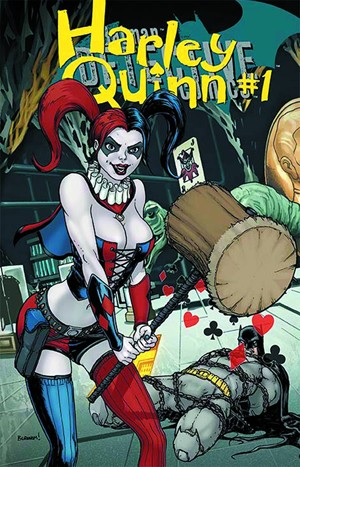
DETECTIVE COMICS: HARLEY QUINN #23.2
Writer: Matt KindtArt: Neil Goode
Publisher: DC Comics
Reviewer: Humphrey Lee
Given, as I’ve stated many, many times by now, the nature of these one-shots to be dissections of the villains taking them over, I think this Harley Quinn info blast may be the tour de force of Villains Month. It runs fast, but it is a really complete and joyfully chaotic dissecting of Harleen Quinzel as her desire to overachieve out of her crowded, white trashish family life eventually arcs into a different kind of chaos once the inmates of Arkham and the Joker eventually infect her with their kind of crazy.
And as disheartening it is to watch Harley break down into the vivacious vixen of violence she is today, it’s also pretty goddamn hilarious, thanks to the comedic expressiveness of Neil Googe’s art. The exaggerated looks of glee on her face as she bludgeons her way into her current getup kind of delight despite the horrific acts at hand.
And then there’s the tragic looks of realization when Kindt kindly lets us know that Harleen is still in there, but is disassociated from the plucky best gal to the Joker she has become while raining terror about Gotham. It’s a subtle move in the midst of the jackhammer-like swath of destruction she’s put on Gotham, basically out of boredom.
Between this handling of such a damaged character and her also somewhat shattered partner – Deadshot – in his Villains Month issue last week, I’m really pretty geeked about the upcoming SUICIDE SQUAD material we will be getting from Matt Kindt. And it gives me hope for a company that has done a pretty crappy job of dealing with talent recently that they can snag one of Kindt’s caliber to do all this work he has so far this month and convince him to (hopefully) run as wild as Harley did this issue on a book such as SUICIDE SQUAD.
Humphrey Lee has been an avid comic book reader going on fifteen years now and a contributor to Ain't It Cool comics for quite a few as well. In fact, reading comics is about all he does in his free time and where all the money from his day job wages goes to - funding his comic book habit so he can talk about them to you, our loyal readers (lucky you). He's a bit of a social networking whore, so you can find him all over the Interwebs on sites like Twitter, The MySpaces, Facebookand a blog where he also mostly talks about comics with his free time because he hasn't the slightest semblance of a life. Sad but true, and he gladly encourages you to add, read, and comment as you will.
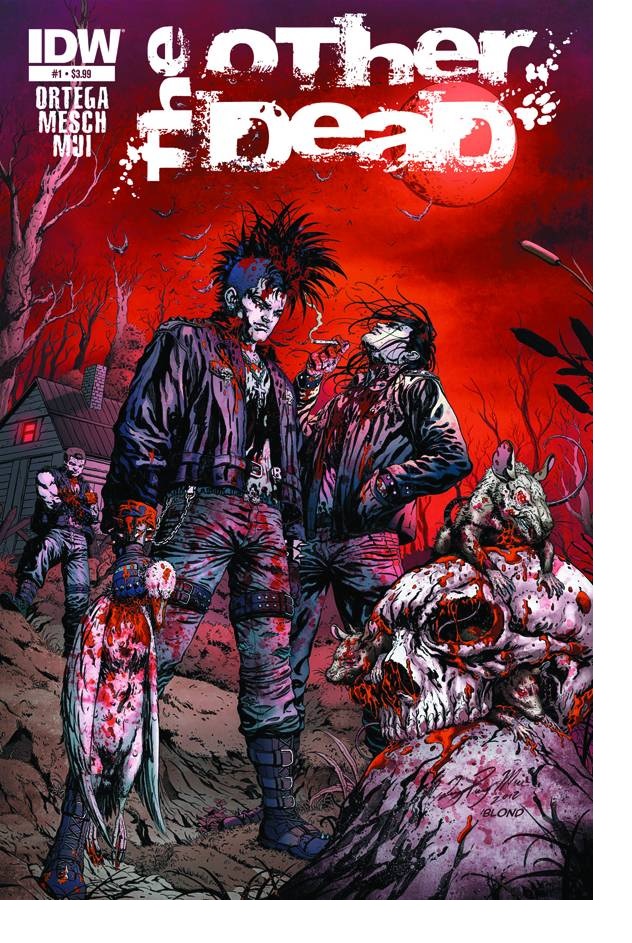 Advance Review: In stores 9/25/13!
Advance Review: In stores 9/25/13!THE OTHER DEAD #1
Writers: Joshua Ortega, Digger MeschArtist: Qing Ping Mui
Publisher: IDW Publishing
Reviewer: Optimous Douche
I’m not tired of zombie books; I’m tired of the same zombie books. This was the mantra for a majority of the geek set about 18 months ago. Hollywood, in its imbecilic wisdom, decided to correct this malaise by doing everything they could to the shuffling undead from finding cures to even having them fall in love. Blech! What the fat cats missed was that books like THE WALKING DEAD focused on how the undead apocalypse would affect the living of this world that were left to pick up the apocalyptic pieces.
Ortega and crew have taken a similar tenor with THE OTHER DEAD, the tale of what happens when our four-legged furry friends succumb to reanimation and an insatiable hunger for human flesh. Even though I’m nestled an hour away from Philly and New York, I live in an area rife with nature and God’s creatures great and small. The one comfort I have when I take my dog, Fergus, for a walk through the woods is that any creature, even some of the ones that could really fuck us up, are more afraid of us than we are of them. What would happen if I walked out of my house one day and a thousand badgers or a pack of bobcats finally realized there was nothing to fear from a city boy and a golden retriever? We would be fucked, because the one element that keeps us at the top of the food chain, that small modicum of reasoning that animals have to scurry, is really the only thing keeping us at the top of the food chain. That’s THE OTHER DEAD.
As I said, though, Ortega and Mesch wisely placed this animal reanimation within the context of the human experience separate from the reanimation. Our tour guide in this world is Tommy, a cherub-faced young lad whose parents predict a comeuppance for us as a species. Ortega sets the tone for this book through Tommy’s recollections of his parent’s words about a death in the air of our society: that we are zombies of a like simply waiting for God to hit a reset button and see who is left. Tommy also is a sickly little boy who spends more time regurgitating food than ingesting it.
This apocalypse is predicated by a voodoo ritual, so naturally our setting is the ballsweat capital of the US, where the humidity is higher than the brain cell count: Louisiana (nothing against the fine state – I just spent a booze-filled weekend in the French Quarter – MENSA applications were on no one’s mind). Tommy’s older brother is the chief culprit of this duck blood-letting ritual. By the close of the first issue we have no idea why he and his friends destroyed Daffy and his friends; just that it set in motion Noah’s wrath on this Earth. I don’t only use the Noah reference for the animals; on top of this, Louisiana is about to get hit by another hurricane (and I don’t mean the kind that comes in a collectible glass from Pat O’ Briens).
A connective tissue that confuses me are two ladies of the pole who work in one of the many dance delight halls on Bourbon Street. It’s wonderful eye candy, and one of them is dating Tommy’s brother. It’s just unclear as to their role in the Dr. Doolittle’s revenge.
Many questions still need to be answered, and that’s a good thing after a first issue. Why the voodoo ritual, why is Tommy always sick, why do strippers have to be such gold digging wh…wait…what do the strippers have to do with the story?
Now, if I haven’t entreated you with the story perhaps I can entice you with the art, because it’s absolutely gorgeous. When Tommy was getting sick over breakfast I almost got sick as well from the sharp detail. Also the zombies, both living and undead, are gorgeously rendered. And the strippers…WOW! Faces are differentiated and expressions run the full gamut of human emotion in stark detail. My only pull out of the book was when the strippers were leaving the club on Bourbon Street and entering their sugar daddy-bought Humvee. I was just on Bourbon this past weekend, the stores are right on top of one another and a Humvee would straddle both sides of the street. Again, something I wouldn’t have noticed had I not just returned, so take my one “criticism” of THE OTHER DEAD with a large pillar of salt.
Oh, the guys are also running a contest to name their letters column. I humbly offer “Squawking Dead.”
Optimous Douche has successfully blackmailed BottleImp to draw purty pictures for his graphic novel AVERAGE JOE coming out in 2013 from COM.X. When not on Ain’t It Cool, Optimous can be found talking comics and marketing on robpatey.com and just marketing on MaaS360.com.
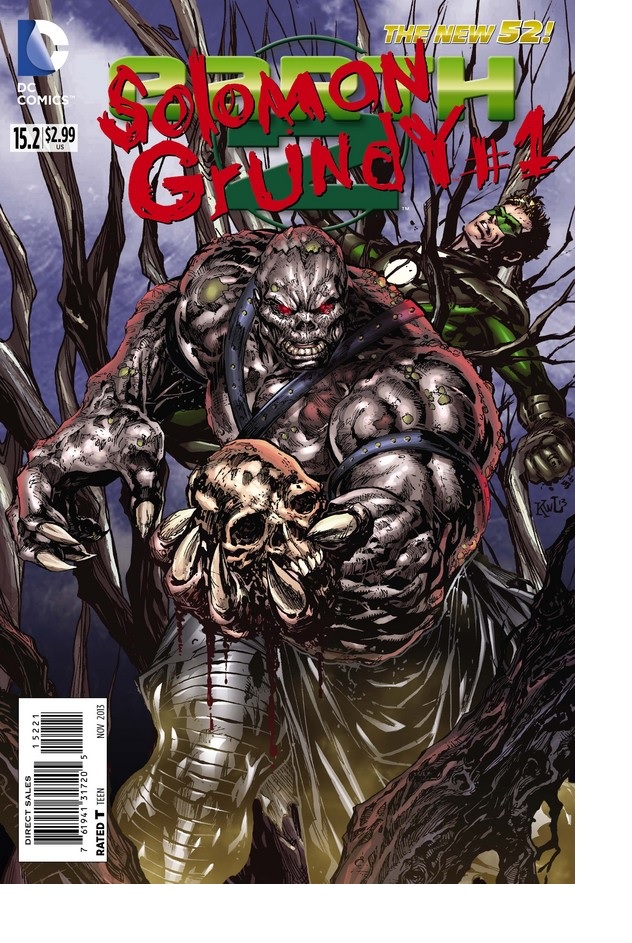
EARTH 2: SOLOMON GRUNDY #15.2
Writer: Matt KindtArt: Aaron Lopreseti
Publisher: DC Comics
Reviewer: Humphrey Lee
Because sometimes you just need an issue numbering that looks like a Dewey Decimal listing, we bring you the second EARTH 2 part of Villains Month. As is the standard set by these, this Solomon Grundy-focused issue is a dive, literally and figuratively, into the murk that is the character’s past.
It’s a gory and tragic tale about simple life-minded Solomon and his wife, Pinney, their work at the local slaughterhouse, and how the verbal and sexual abuse the owner forced on Pinney led to her suicide and Solomon’s mass murder of the owner and workers because, fuck it, that’s what a man does. And as in the nursery rhyme any DC fanperson has read over and over again, he’s reborn on a Monday. It’s gruesome, heartbreaking, and tragic and solidly executed by Matt Kindt and company.
Unfortunately, that part of this issue barely registers in at seven of this comic’s twenty pages, and the rest is dedicated to the return of Grundy in the present day from his moon exile at the hand of Alan Scott in his first outing as the Green Lantern. Those parts of the comic also just lead to more death and ruined lives, but without any of the poignancy--just the non-discerning mayhem we’ve come to expect from the character.
Basically, this is a comic with its share of moments, brutal as they are, but for the most part lacks depth just like the swamps Solomon was born from, sad to say.
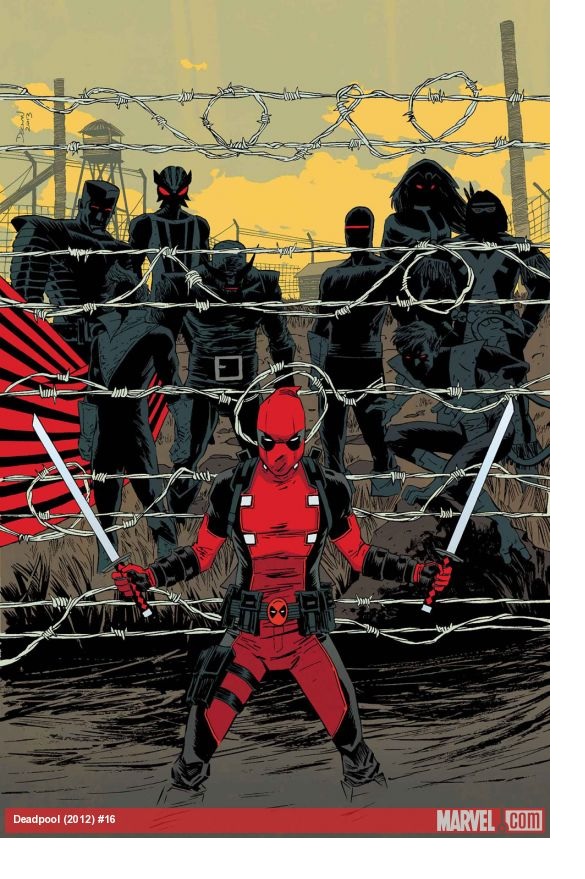
DEADPOOL #16
Writers: Brian Posehn & Gerry DugganArtist: Declan Shalvey
Publisher: Marvel Comics
Reviewer: The Kid Marvel
As I wrote a couple weeks ago, I’m a huge fan of Posehn and Duggan’s run on DEADPOOL and the writing they have been doing. This is mostly due to the fact the comedy in the stories has been excellent and they’ve kept Deadpool extra entertaining, in my humble opinion, of course. The duo’s take on Deadpool has mostly been focused on the class clown Wade Wilson, who’s looking for legitimacy among the established heroes, and of course dropping tons of witty humor and potty jokes like only the Merc With The Mouth can in the process. However, with the second part of “The Good, the bad, and the Ugly” arc in DEADPOOL NOW, it seems that Posehn and Duggan will be getting a little more serious in their writing by delving into a somewhat forgotten take on the character of Wade Wilson.
DEADPOOL 15 left off with Wade believing he was captured by Butler, stuck in a tank, then having his body used for various tests and experiments on his healing factor. At the beginning of DEADPOOL 16, Deadpool begins to break through the hallucinogenic and coma-inducing chemicals he’s being pumped with after having a dark nightmare relating to his inner loneliness. After busting out of his tank, Wade then proceeds to kill every single scientist and doctor who’s been working on him in a very similar fashion to his BFF Wolverine. After working his way outside and forcing Butler to give him some information, Wade meets some individuals who Butler’s been experimenting on with Deadpool’s harvested organs over the years. After a little back and forth, Butler drops a bomb (figuratively) on Wade, revealing a secret about a living relative of his. The news throws Deadpool for a loop before Butler blows Wade’s mind again, this time literally. This is where things change from the typical upbeat Deadpool as a character to a darker tone and more tormented individual. Deadpool just sits captured and chained in silence, while Preston is trying to get the always talkative Merc to speak, or to even have some internal dialogue for that matter, but to no avail. The story doesn’t end here, with a couple more twists and turns before DEADPOOL 16 and part two of this arc comes to a close.
I enjoyed the change of pace in DEADPOOL, and thought highlighting Deadpool’s inner demons showed growth in the Posehn/Duggan writing framework since the first issue. I love the comedic DEADPOOL issues, because who doesn’t like to laugh? However, I know more hardcore fans of Wade and longtime fans have voiced their disdain for the constant jokes and lack of character they feel Deadpool has become recently. Myself, I’ll take either or just because I love basically anything Deadpool, serious or light-hearted, but having different dynamics and tone in these stories is always needed to keep things fresh and interesting, so I’m happy to see the shift in tone.
The only complaint I have is the Agent Preston bit and her still being trapped in Deadpool’s psyche. It’s gotten old, and frankly I don’t give a sh@# about her in the slightest. While having someone to pick Deadpool out of his depression was needed in this issue, it could have been done by someone else. Overall, Preston’s constant presence got old quick and is way past its welcome.
As for DEADPOOL 16’s artwork, there are no complaints from me in that department. I like Shalvey’s rough style, and thought it worked excellently with Wade’s constant rotting flesh and the action scenes. The limited details in character structure have worked well with the story; there’s enough dialogue that you don’t need the art to carry the story along--it does that for itself.
Overall, other than a few minor things such as Agent Preston, DEADPOOL 16 was a great read and continues to be one of the titles I look forward to picking up from my bin. I liked the change of pace and the added element of another person of the Wilson lineage, messing with the very rarely stunned Deadpool. I’m hoping the quality of this book continues, and is able to change tones consistently in order to keep the awesome character of Deadpool surrounded by stories just as awesome.

BATMAN: RIDDLER #23.2
Writers: Scott Snyder & Ray FawkesArt: Jeremy Haun
Publisher: DC Comics
Reviewer: Humphrey Lee
Much like the Two-Face story of Villains Month last week, this Riddler tale is way more a tale of the present with the occasional flashback, as opposed to being much more origin-focused, as most of these one-shots have been. Similar to that issue as well, this tale is more a showcase of the trademark of the character – in Two-Face’s case it was his struggle with his duality and in this case it’s the Riddler’s themed schemes – with the backdrop of a world in chaos due to the events of FOREVER EVIL.
As with the vast majority of Batman’s villains, the appeal of The Riddler lies in the eccentricities of the character, which Scott Snyder and Ray Fawkes (with Jeremy Haun on pencil duties) convey here in spades. From the nonchalant way he strolls through Wayne Tower and dons his work garb to his little Jokeresque knickknacks and devices to his violent swings when he’s even slightly interfered with, it’s a nice showcase about what I enjoy about this character; he’s pretty much diametrically opposed to the Joker, whose schizoid personality betrays his cunning, Riddler has a composed and detailed preparation that shatters as easily as his ego.
And all of this comes into play as a plot behind the plot of seizing Wayne Enterprises rears its head and it’s basically a revenge scheme against an Arkham guard who mistreated him once upon a time. It’s a nice payoff to a well-orchestrated character study and another tick in the “this ain’t so bad” column that is this Villains Month diversion.

PARIAH MISSOURI OGN
Writer: Andres SalazarArtist: Jose Pescador
Publisher: SE Studios (via Kickstarter)
Reviewer: Optimous Douche
I only play the Kickstarter “make a wish” review game if a project meets three criteria: One, the would-be creators need to have a finished product. It can be one issue and most certainly digital; I’ll never shun a Kickstarter for trying to buy pulp. Two, you’re not running the Kickstarter to buy an artist. Sorry, but if an artist really believes in a project with true passion, they will give their time knowing rewards will come soon (note to writers--start offering more percentages on the back end, you cheap bastards – artists work hard). Three, it must be a decent book. I really don’t revel in shitting on people’s dreams; nor will I ever mislead my readership so someone can feel good about something they created. I’ll always gladly give feedback on an idea, but a review is a coveted prize I simply won’t prostitute.
PARIAH MISSOURI more than passes muster on all necessities for review love. This tale about a bloodsucking group of thespians in the mid-1800s could easily sit with an indie publisher. The first volume OGN is a satisfyingly complete story with the freedom of indie charm, but the production discipline required for a paid price of admission.
What’s even cooler about this book is it’s fueled by ambition along with some great characters. This is Salazar’s second time to the Kickstarter well. I reviewed the first couple issues many months ago when Salazar was trying to get funding for just them. Now, he’s going for the gold to close out this full chapter about Pariah’s denizens. Now we stand with a full completion of the book in four beautiful chapters, along with all of the extra trappings of bookmarks and bonus material that have become Kickstarter staples.
OK, enough about Kickstarter--so what’s PARIAH MISSOURI all about? Well, a lot actually. It’s more than just a vampire tale, or about the forces of good that come to Pariah to fight them. It’s about the dreams of the old West, the promise of a better life. For some characters this comes true, and for others the copious amounts of dust on the ground are symbolic of all they were able to achieve in this new promised land.
Every character, though, has a dual purpose--the mask they wear as townfolk and the true identity as either a force of good or evil. It’s this personality subterfuge I found most engaging, and the book’s most unique element. There’s Hiram, the dandy fop who is more card shark than hero – at least when the book starts. Then there’s Nellie, the daughter of the hotelier who is ran out of town for gambling debts. Forced to make her own way, she is the embodiment of Ol’ West grit and determination on the work front and pure heroism on the vampire side of things. The Indian shaman, the slave with a past and deep knowledge of Creole voodoo, the new hotelier who is carrying more secrets than keys, and finally a Marshal seeing retribution.
If I had to make one critique of the story I would say Salazar almost packed in too much for an inaugural volume. This is the ADD generation, after all. Thankfully, the book comes with a complete ol’ timey org chart in the back to help keep everyone straight. The vampire story almost feels secondary to the rich lives of the townsfolk, but I understood their purpose, especially in light of the tee up for volume 2 at the end.
The art style is very sketchy, yet there’s detail inside, especially with the faces, which is important since there are so many damn whiteys in the ol’ West. Dusty, I guess, would be the best way to describe it. It works, especially in light of the material. I will say, however, I found the coloring a little too overpowering. The book is either very orange or very blue depending on the time of day or night. I know what Salazar was going for here, but again, it feels very heavy-handed.
My coloring nit is just that, though--a nit. Don’t let it stop you from taking a trip down the Ol’ Miss to PARIAH MISSOURI.
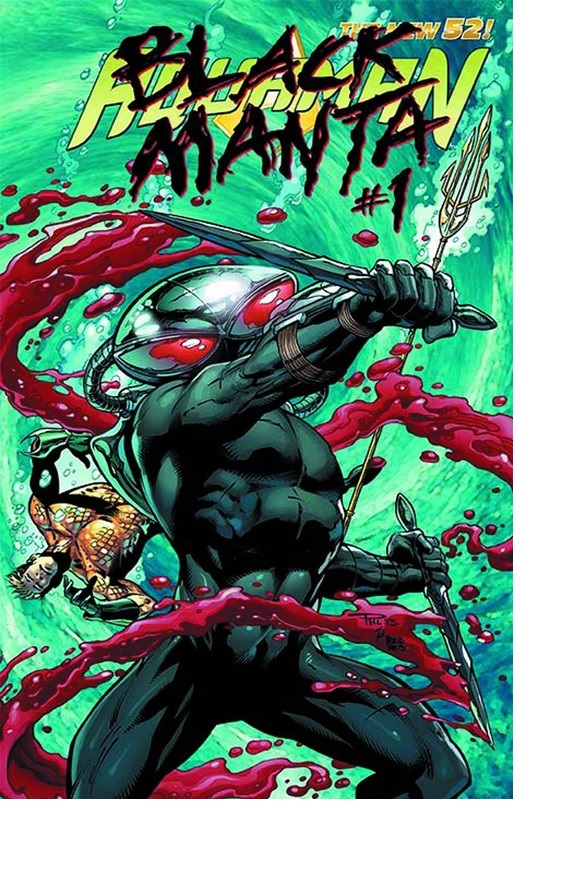
AQUAMAN: BLACK MANTA #23.1
Writer: Geoff Johns and Tony BedardArtist: Claud St. Aubin
Publisher: DC Comics
Reviewer: Masked Man
Forever Evil crossovers continue to roll out this month, and this issue of AQUAMAN is dedicated to his main villain: Black Manta! While there's no way I'm buying all of these villain issues I had to get Black Manta, because hey, it's Black Manta! How can anyone who watched the SUPERFRIENDS not be a fan of this guy? I'd bet that's why Geoff Johns and Alex Ross are fans. So I read the issue, and...I want my money back.
Now, was it a bad issue? No, not at all. It's just that I already read this issue. It pretty much just retells the plot of FOREVER EVIL #1 (Black Manta was heavily used in the issue, if you didn't know). So I spent four frick'n dollars to have Johns tell me the same story slower! To be fair, there were seven pages of new material, which seriously could have been told in three pages--but since this issue had almost nothing to say, it was important to make sure each story point lasted as long as humanly possible. Spoiler time: the only real advancement of plot is that Black Manta is now against The Crime Syndicate ( I just saved you $4--you're welcome). Seriously, did Johns really think that there was anyone out there who would buy AQUAMAN #23.1 and not get FOREVER EVIL #1? Really?
Artist Claud St. Aubin does a reasonable job of redrawing David Finch's pages. The new tidal wave scene was nice, though his depiction of the Crime Syndicate on page 12--yikes! St. Aubin is a fine artist, but I don't think he's quite primetime. I expect a high leveler of artistry from DC, but then I guess this was just a cash grab issue.
Lastly, because I'm feeling a little surly at the moment (because of this issue) I'll expose DC's marketing department fraud: the covers are not 3D, they are lenticular. Lenticular artwork has been around a long time--I remember having several storybooks as a child that were lenticular. I assume DC didn't think fans would pay an extra dollar for a lenticular cover, but they would for a 3D cover. Halfway into this Forever Evil month and issues have ranged from decent to crummy. Makes me think readers should have skipped the whole month, aside from FOREVER EVIL itself. Let all the guys still hoarding their ROBIN II hologram card covers buy these.
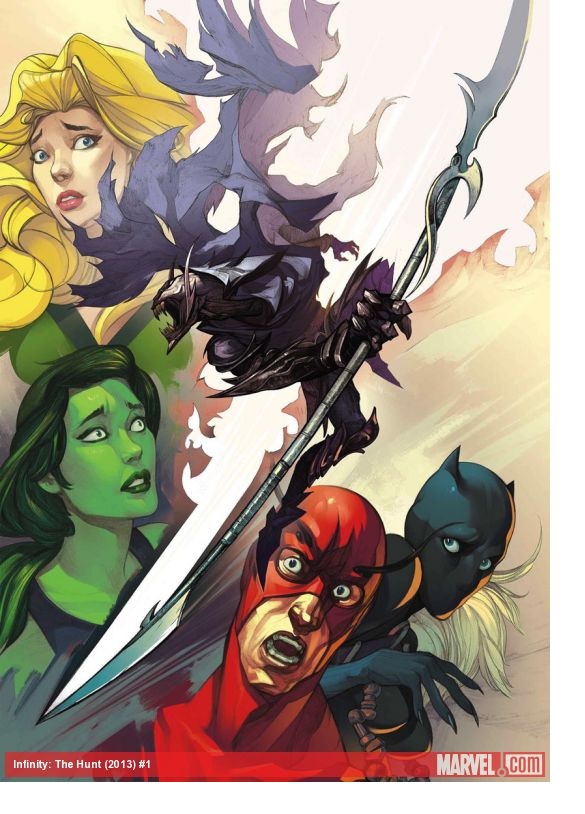
INFINITY: THE HUNT #1
Writer: Matt KindtArt: Steven Sanders
Publisher: Marvel Comics
Reviewer: Henry Higgins is My Homeboy
Goddamnit, INFINITY.
You were doing so well. Okay, sure, you may be confusing and scattered at times, but you’ve been able to stay a relatively consistent story. The tie-ins have been well executed, the process of events make sense, and they have actually impacted the story in subtle ways. MIGHTY AVENGERS is even a solid point in the week’s comic purchases. But then THE HUNT came out, and just couldn’t connect on any level.
It might be that, for a tie-in to a relatively fast paced crossover (there’s already been A LOT of big name fights in this series), this is perhaps the slowest issue of a comic I’ve read in some time. The book, beginning an hour before the invasion fleet hits Earth, centers around a new CONTEST OF CHAMPIONS, designed as intermural games between the various superhero academies of the world. It’s a fun idea and could lend itself well to a short story, but not only does it ratchet the ongoing story back a ways, it’s also muddled and just plain dull.
Introducing so many characters in such a short amount of time is a very tricky maneuver, but Kindt isn’t able to add any originality to it. It eventually devolves into the backs of trading cards, listing off quick motivations and power descriptions. Kindt does manage to give some characters more dimension, but it’s just not enough to distract from the nigh-constant exposition. If someone isn’t explaining some minute detail about the Marvel universe, they’re expounding the most basic of their character traits.
The sad part is, there are some genuine moments of creativity and inspiration here and there, with little flourishes like the triplets clawing at the panel border in fear or the revelation that Quentin definitely has a type, but those moments are few and far between. Hopefully there isn’t a single other piece of exposition and the rest of the miniseries is just fun.
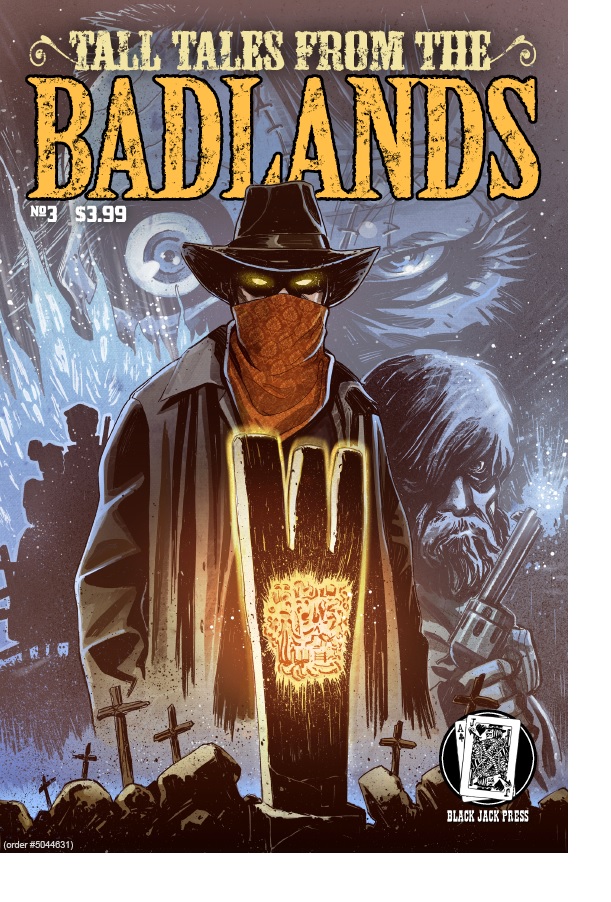
TALL TALES FROM THE BADLANDS #3
Writers: Mark Wheaton, Sean Fahey, Robert Napton, Matt DembickiArtists: Jerry Decaire, John Fortune, Franco Cespedes, Ezequiel Rosingana, Ruben Rojas
Publisher: Black Jack Press and available in print through indyplanet.com and digital though graphicly.com, Drive Thru Comics, and My Digital Comics
Reviewer: BottleImp
The premiere issue of TALL TALES FROM THE BADLANDS, a Western-themed anthology series, had a tremendous impact on me. First off, it cured me of my irrational prejudice against any sort of story set in the Wild West. Second, it was just an amazing assortment of well-crafted stories. Let’s face it: when it comes to anthology format comic books, sometimes it’s impossible to find a single decent tale in the bunch, let alone a whole issue’s worth. That first issue beat the odds and was chock full of engaging, intriguing visions of life on the prairie, but I felt that the second issue of this series, though still well-crafted, was lacking in the “tall” element of these tall tales. Well, either my critique was taken under consideration or the stars simply aligned to form a perfect synchronicity, because this third issue of TALL TALES delivers on the promise inherent in the title—and in weird, wonderful ways.
As before, writer/editor Sean Fahey has assembled a stellar collection of stories of the Old West, leading off with Mark Wheaton and Jerry Decaire’s “The Judgment of the People.” The harsh justice system of the West is used as the springboard for this story of a corrupt judge who eventually faces judgment handed down from those he wronged. Wheaton expertly blends the supernatural with real-life horrors, and DeCaire’s crisp black and white artwork captures both the everyday and the unearthly with a grim clarity.
No supernatural elements to be found in Fahey’s “Apologies”, yet this story resonates with a horror all its own. A family lost in the wilderness must choose whether to hope for rescue or succumb to despair. John Fortune’s cartoony artwork gives this tragic life-or-death story a sense of dynamic energy that drives the reader through to the final, awful panels.
“Rustlers” is probably the most outrageous story in this issue, and one of the most fun to read. A troop of bandits gets more than they bargain for when they hijack a train to rob a wealthy cattle baron of his mysterious cargo. Robert Napton mashes together some of the finest tropes of the Wild West with one of the horror genre’s hoariest concepts to give a great EC-style twist to this tale. Franco Cespedes’ pages are a masterwork of dynamic page composition and deceptively simple clarity, making “Rustlers” a jaunty rollercoaster of a read.
The Old West cliché of the haunted gold mine gets a twist in “All Mine,” written by Matt Dembicki with art by Ezequiel Rosingana. This is probably the weakest entry in this issue’s lineup; the story never quite comes together in the end and the artwork, though decent, lacks the graphic punch that the other Tall Tales possess. Not bad, but not great.
TALL TALES wraps up its third issue on a high note with “Where the Heart Is,” written by Sean Fahey with art by Ruben Rojas. Though lacking the horror element found in the other stories, this tale is no less weird, a seemingly prosaic story about life out on the range that takes an abrupt twist worthy of “The Twilight Zone.” More Ray Bradbury than Robert Bloch, “Where the Heart Is” ends this installment of the anthology on a gently humorous note, and is my favorite story of this issue.
The quality of this comic—both in terms of storytelling and black and white artwork—is fantastic. The melding of the various genres is seamless. TALL TALES FROM THE BADLANDS has once again made me fall in love with Westerns, and once again I can’t wait to see what the next issue has in store.
When released from his bottle, the Imp transforms into Stephen Andrade, an artist/illustrator/pirate monkey painter from New England. He's currently hard at work interpreting fellow @$$Hole Optimous Douche's brainwaves and transforming them into pretty pictures on AVERAGE JOE, an original graphic novel to be published by Com.x. You can see some of his artwork here.
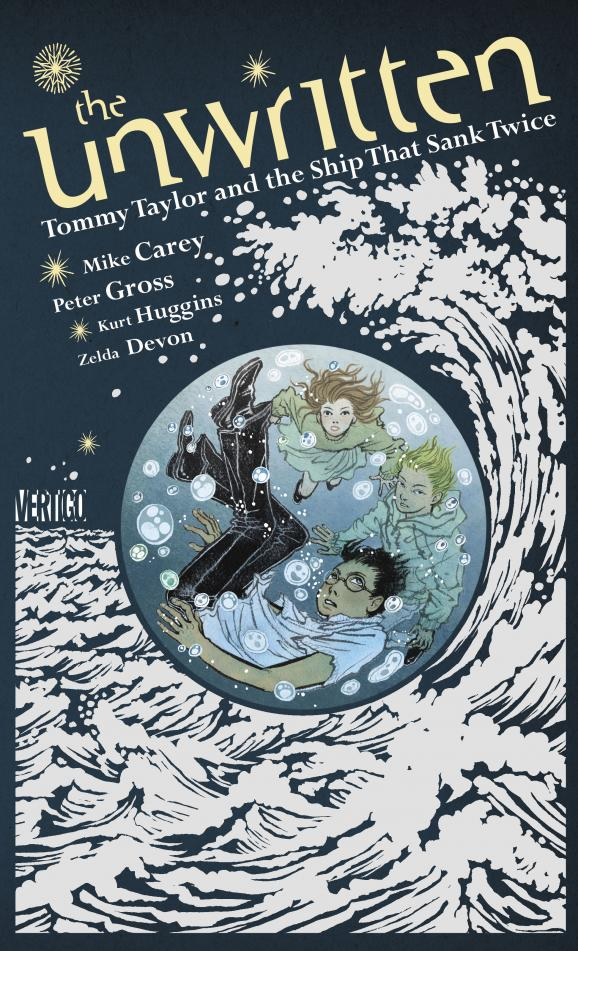 Advance Review: In stores today!
Advance Review: In stores today!UNWRITTEN: TOMMY TAYLOR AND THE SHIP THAT SANK TWICE OGN
Writer: Mike CareyArtist: Peter Gross, Kurt Huggins
Publisher: DC Vertigo
Reviewer: Optimous Douche
If you’ve been following UNWRITTEN, the book whose veneer shines of pastiches that range from HARRY POTTER to the BOOKS OF MAGIC, you must buy this original graphic novel. Not only is it gorgeously crafted with its hardbound cover and high-gloss paper, this is essentially the Rosetta Stone to the mystery of how Tom and Tommy Taylor came to be. It’s the insight into their father, Wilson, UNWRITTEN fans have waited a very long time to see.
If you haven’t been following this book, chances are you shunned it for the very pillars I used in my description. But I’ve never seen UNWRITTEN being about magic or simply a cautionary tale for Daniel Radcliffe. All of that ended after the first story arc. UNWRITTEN explores the very inception of ideation and creation. As a man without much mystical or spiritual faith, I have always questioned whether humans create what we dream or if we are simply conduits receiving signals to facilitate a grander plan. Carey seems to have no such waffling (at least on paper); what man creates can and will come to fruition through story, then in true form. It’s the Tinkerbell concept taken to hyperbole; if we all believe at once the public zeitgeist can make any flight of fancy as tangible as the nose on your face.
All right--enough of the meta. The actual story lives in a duality between Wilson Taylor’s creation of two mystical boys and how much easier it was to create the fictional Tommy versus raising the real Tom. Writers well know the torturous existence our stories create for our souls and personal lives. We live in ideas, and very often those ideas close out the rest of the world around us. When locked in imagination it’s very easy to lose those that have honored us with their love; they don’t know the story, and their needs get in the way of us releasing the story on page. For most writers this drive isn’t malicious or calculated. We simply need space. Wilson Taylor is the opposite; in his drive to imbue a real boy with magic he used all those around him until his soul and theirs were completely spent. Through journal entries we see the beginning of Wilson’s plan unfold, while the other half of the story tells the origin of Tommy Taylor and his discovery of the magical spark.
It’s hard to tell which story was the better of the two, since both tickled different parts of my cerebellum. Despite their connective tissue of magic’s inception they can certainly be read very separate and apart, especially since we are now well into Tom Taylor’s journey after cresting the 50th issue mark recently. Creating magic in the real world is a twisted dark affair wrought with a Machiavellian usage of real people to serve Wilson’s ends. Tom’s mother is a nervous breakdown waiting to happen until it does, and Wilson, like Honey Badger, doesn’t give a shit. The boy who would one day become a wizard also spends the first two years of his life in relative solitude. Even if one takes away the story deprivation tank Wilson crafted to infuse Tom with copious amounts of literature through osmosis, his time outside the tank is just as lonesome as Wilson builds an empire and transforms the fabric of reality. The cruelest measure was fitting Tom with a pair of spectacles for his first birthday without even a hint of myopia in the lad. But as Wilson explains it, the reflection must be perfect.
Tommy’s story, on the other hand, is brimming with optimism despite his hardships before discovering the magical spark. An entire world changes when Tommy discovers his true gift of magic, making Harry Potter’s Christ aspirations seem very limited since the muggle world doesn’t change one iota after Harry defeats Voldemort or discovers he’s special. Tommy is also far more heroic than his borrowed personas. Despite his parents passing, then subsequent servitude at the school of magic, there’s an air of confidence and surety we never saw from the boy under the stairs. Tommy is far more of a leader to his Hermione and Ron as opposed to a scrum player.
It’s funny; Carey actually doesn’t give himself enough credit for just how wonderful and original THE SHIP THAT SANK TWICE truly is. In one journal entry Carey speaks through Wilson about THE BOOKS OF MAGIC and other properties he borrowed from, so capturing public imagination would come easier. Also, Carey stated in a recent interview (or in my PR letter, I can’t remember which) that he was happy he didn’t have to create a full narrative for this first foray into the TOMMY TAYLOR novels. I personally thought this was a pretty fleshed-out story, which while borrowing from other sources is truly and wholly original, especially the ending of the book where Tommy basically imbues his entire world with magic. Even if Book One does borrow heavily from the Potter novels, Book Two will certainly be something wholly unique. That last line is a hint. I would love to read the other six TOMMY TAYLOR books. I’m not sure I want to see them tomorrow, but perhaps after UNWRITTEN has run its course?
The art is spectacular, as expected. It’s clear when the pencil changes hands, but since the book lives on two planes I wouldn’t expect any less of a shift. The world of Wilson and young Tom is as dark and foreboding as one would expect from my descriptions. It’s also a lot of close-up shots of a man about to sell his soul for his beliefs. The world of Tommy is as light and effervescent as the hypercolors on J.K. Rowling’s creations--a charcoal-like dream melting into your eye sockets.
As I stated at the beginning, this book is a no-brainer for current UNWRITTEN fans. However, after this reflection I’ll say you truly NEED this book to understand the full UNWRITTEN story. Wilson came and went from the main comic so quickly we never gained true insight into his megalomania. Also, any true UNWRITTEN fan should want to spend some time with the books that have given our favorite protagonist such trouble throughout his life. If you’re new to UNWRITTEN, you’ll actually get what’s going on, but I don’t think you’ll care as much as true fans of the series. So buy TOMMY TAYLOR AND THE SHIP THAT SANK TWICE, stick it on a shelf, then go buy and read the first two or three trade volumes.
Editing, compiling, imaging, coding, logos & cat-wrangling by Ambush Bug
Proofs, co-edits & common sense provided by Sleazy G
Remember, if you have a comic book you’d like one of the @$$holes to take a look at, click on your favorite reviewer’s link and drop us an email.
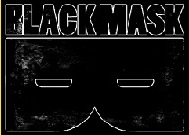 Find out what are BLACK MASK STUDIOS and OCCUPY COMICS here and on Facebook here!
Find out what are BLACK MASK STUDIOS and OCCUPY COMICS here and on Facebook here!
 Want more in all things Geek?
Want more in all things Geek?
Check out PoptardsGo and on Facebook here!
 Get your copy of highly-anticipated anthology TOME by 44FLOOD here!
Get your copy of highly-anticipated anthology TOME by 44FLOOD here!
Check out AICN COMICS on Facebook and Comixpedia.org!
Reviewer: Optimous Douche
If you’ve been following UNWRITTEN, the book whose veneer shines of pastiches that range from HARRY POTTER to the BOOKS OF MAGIC, you must buy this original graphic novel. Not only is it gorgeously crafted with its hardbound cover and high-gloss paper, this is essentially the Rosetta Stone to the mystery of how Tom and Tommy Taylor came to be. It’s the insight into their father, Wilson, UNWRITTEN fans have waited a very long time to see.
If you haven’t been following this book, chances are you shunned it for the very pillars I used in my description. But I’ve never seen UNWRITTEN being about magic or simply a cautionary tale for Daniel Radcliffe. All of that ended after the first story arc. UNWRITTEN explores the very inception of ideation and creation. As a man without much mystical or spiritual faith, I have always questioned whether humans create what we dream or if we are simply conduits receiving signals to facilitate a grander plan. Carey seems to have no such waffling (at least on paper); what man creates can and will come to fruition through story, then in true form. It’s the Tinkerbell concept taken to hyperbole; if we all believe at once the public zeitgeist can make any flight of fancy as tangible as the nose on your face.
All right--enough of the meta. The actual story lives in a duality between Wilson Taylor’s creation of two mystical boys and how much easier it was to create the fictional Tommy versus raising the real Tom. Writers well know the torturous existence our stories create for our souls and personal lives. We live in ideas, and very often those ideas close out the rest of the world around us. When locked in imagination it’s very easy to lose those that have honored us with their love; they don’t know the story, and their needs get in the way of us releasing the story on page. For most writers this drive isn’t malicious or calculated. We simply need space. Wilson Taylor is the opposite; in his drive to imbue a real boy with magic he used all those around him until his soul and theirs were completely spent. Through journal entries we see the beginning of Wilson’s plan unfold, while the other half of the story tells the origin of Tommy Taylor and his discovery of the magical spark.
It’s hard to tell which story was the better of the two, since both tickled different parts of my cerebellum. Despite their connective tissue of magic’s inception they can certainly be read very separate and apart, especially since we are now well into Tom Taylor’s journey after cresting the 50th issue mark recently. Creating magic in the real world is a twisted dark affair wrought with a Machiavellian usage of real people to serve Wilson’s ends. Tom’s mother is a nervous breakdown waiting to happen until it does, and Wilson, like Honey Badger, doesn’t give a shit. The boy who would one day become a wizard also spends the first two years of his life in relative solitude. Even if one takes away the story deprivation tank Wilson crafted to infuse Tom with copious amounts of literature through osmosis, his time outside the tank is just as lonesome as Wilson builds an empire and transforms the fabric of reality. The cruelest measure was fitting Tom with a pair of spectacles for his first birthday without even a hint of myopia in the lad. But as Wilson explains it, the reflection must be perfect.
Tommy’s story, on the other hand, is brimming with optimism despite his hardships before discovering the magical spark. An entire world changes when Tommy discovers his true gift of magic, making Harry Potter’s Christ aspirations seem very limited since the muggle world doesn’t change one iota after Harry defeats Voldemort or discovers he’s special. Tommy is also far more heroic than his borrowed personas. Despite his parents passing, then subsequent servitude at the school of magic, there’s an air of confidence and surety we never saw from the boy under the stairs. Tommy is far more of a leader to his Hermione and Ron as opposed to a scrum player.
It’s funny; Carey actually doesn’t give himself enough credit for just how wonderful and original THE SHIP THAT SANK TWICE truly is. In one journal entry Carey speaks through Wilson about THE BOOKS OF MAGIC and other properties he borrowed from, so capturing public imagination would come easier. Also, Carey stated in a recent interview (or in my PR letter, I can’t remember which) that he was happy he didn’t have to create a full narrative for this first foray into the TOMMY TAYLOR novels. I personally thought this was a pretty fleshed-out story, which while borrowing from other sources is truly and wholly original, especially the ending of the book where Tommy basically imbues his entire world with magic. Even if Book One does borrow heavily from the Potter novels, Book Two will certainly be something wholly unique. That last line is a hint. I would love to read the other six TOMMY TAYLOR books. I’m not sure I want to see them tomorrow, but perhaps after UNWRITTEN has run its course?
The art is spectacular, as expected. It’s clear when the pencil changes hands, but since the book lives on two planes I wouldn’t expect any less of a shift. The world of Wilson and young Tom is as dark and foreboding as one would expect from my descriptions. It’s also a lot of close-up shots of a man about to sell his soul for his beliefs. The world of Tommy is as light and effervescent as the hypercolors on J.K. Rowling’s creations--a charcoal-like dream melting into your eye sockets.
As I stated at the beginning, this book is a no-brainer for current UNWRITTEN fans. However, after this reflection I’ll say you truly NEED this book to understand the full UNWRITTEN story. Wilson came and went from the main comic so quickly we never gained true insight into his megalomania. Also, any true UNWRITTEN fan should want to spend some time with the books that have given our favorite protagonist such trouble throughout his life. If you’re new to UNWRITTEN, you’ll actually get what’s going on, but I don’t think you’ll care as much as true fans of the series. So buy TOMMY TAYLOR AND THE SHIP THAT SANK TWICE, stick it on a shelf, then go buy and read the first two or three trade volumes.
Proofs, co-edits & common sense provided by Sleazy G
 Find out what are BLACK MASK STUDIOS and OCCUPY COMICS here and on Facebook here!
Find out what are BLACK MASK STUDIOS and OCCUPY COMICS here and on Facebook here! Want more in all things Geek?
Want more in all things Geek?Check out PoptardsGo and on Facebook here!
 Get your copy of highly-anticipated anthology TOME by 44FLOOD here!
Get your copy of highly-anticipated anthology TOME by 44FLOOD here!Check out AICN COMICS on Facebook and Comixpedia.org!
